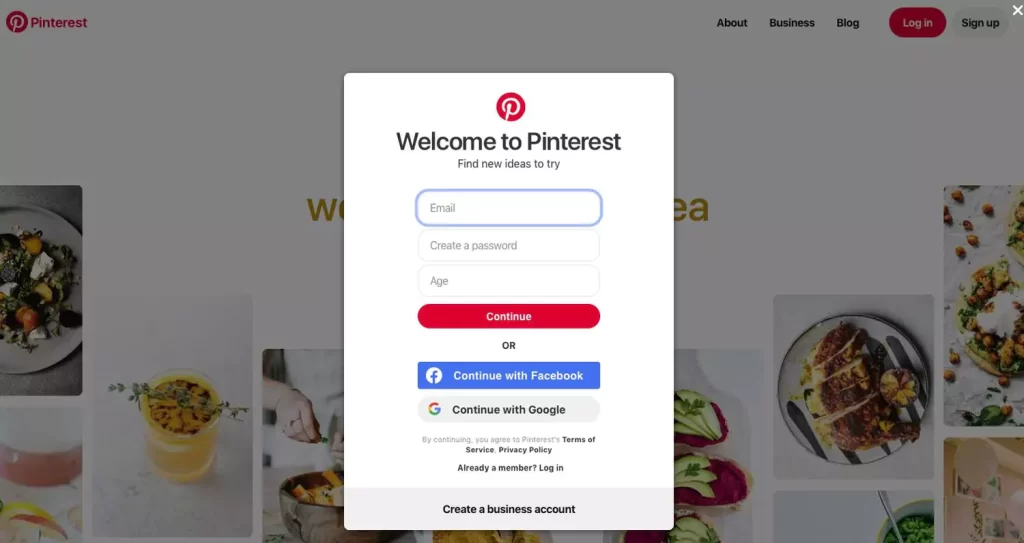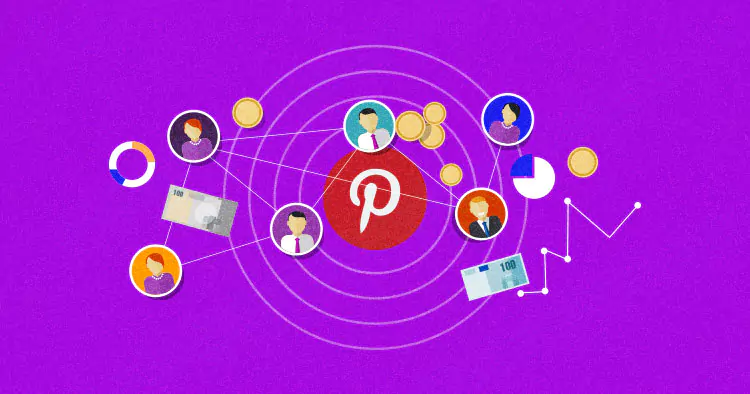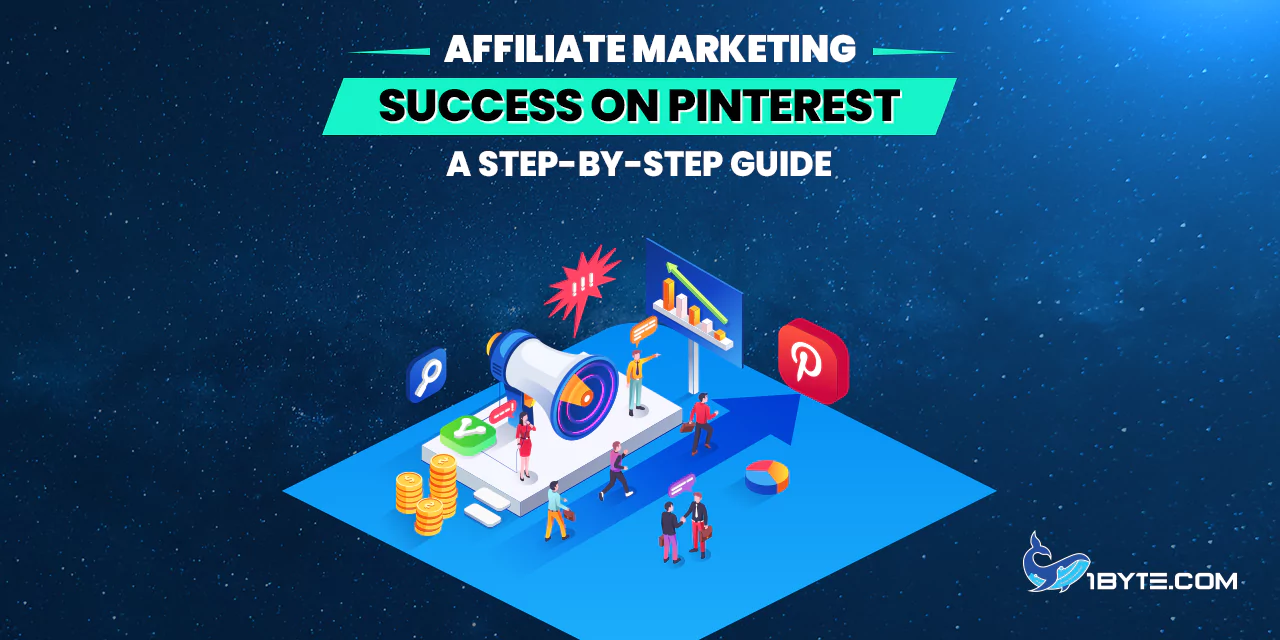Are you ready to explore the world of affiliate marketing on Pinterest? In this step-by-step guide, we at 1Byte will unravel the secrets behind successful affiliate marketing on Pinterest. Whether you’re a seasoned marketer or just starting, our comprehensive insights will help you navigate this unique platform and maximize your affiliate earnings. Let’s dive in and discover how you can harness the power of Pinterest for your affiliate marketing endeavors.
Setting Up Your Pinterest Account
Now, let’s get started by setting up your Pinterest account for successful affiliate marketing on Pinterest. Creating a Pinterest business account is the first crucial step in your journey. This guide will walk you through the process, ensuring you have a solid foundation to launch your affiliate marketing efforts on Pinterest effectively. So, let’s roll up our sleeves and begin your Pinterest affiliate marketing journey by setting up your account.
FURTHER READING: |
| 1. Is Your Dropshipping Venture Legal? Things You Must Know |
| 2. How to Start Dropshipping: A Guide |
| 3. How to Get Money on Steam: 7 Legit Ways to Earn or Redeem Funds |
Creating a Pinterest business account
Creating a Pinterest business account is the first vital step in launching your affiliate marketing journey on Pinterest. Here’s how to do it:
- Go to Pinterest: Visit the Pinterest website and click on the “Sign up” button.
- Choose Business Account: When prompted, select the option to create a business account. This is essential for affiliate marketing as it offers tools and analytics not available with a personal account.
- Fill in Details: Enter your email address, password, and business name. Ensure the business name reflects your niche or affiliate marketing focus.
- Add Profile Information: Upload a profile picture or logo that represents your brand. Write a brief but engaging bio that conveys your affiliate marketing niche.
- Verify Your Website: Pinterest allows you to claim your website, which adds credibility to your profile. Follow the instructions to verify ownership of your website.
- Set Up Boards: Create a few boards related to your niche. This shows your expertise in the field and provides spaces to pin your affiliate products later.
- Connect Social Accounts: Link your other social media accounts, such as Instagram or Facebook, to your Pinterest business account. This can help expand your reach.
- Adjust Settings: Customize your notification preferences and privacy settings according to your preferences.
- Explore Pinterest: Familiarize yourself with the platform by browsing through various pins and boards. This will give you insights into how Pinterest works.
By creating a Pinterest business account, you’re laying the foundation for your successful affiliate marketing journey on Pinterest, unlocking the platform’s business-specific features and capabilities. Now, you’re ready to optimize your profile for affiliate marketing.
Optimizing your profile for affiliate marketing

Optimizing your Pinterest business account for affiliate marketing is crucial to attract and engage your target audience effectively. Here’s how to do it:
- Update Profile Information: Ensure that your profile picture, business name, and bio are all relevant to your affiliate marketing niche. Use the focus keyword “affiliate marketing on Pinterest” naturally within your bio.
- Keyword-Rich Boards: When creating boards, use descriptive names that include keywords related to your niche. For example, if your niche is “fitness products,” name your board “Top Fitness Products.”
- Board Descriptions: Write concise yet informative descriptions for each board, incorporating keywords naturally. These descriptions help Pinterest understand the content of your boards.
- Custom Board Covers: Create custom board covers that are visually appealing and align with your affiliate marketing theme. This adds a professional touch to your profile.
- Consistent Branding: Maintain a consistent visual style across your pins and boards. This helps in brand recognition and makes your profile look more professional.
- Pin High-Quality Content: Prioritize quality over quantity. Pin high-quality images and videos related to your niche. Ensure that your affiliate products are visually appealing and well-represented.
- Keyword-Rich Pin Descriptions: Craft keyword-rich descriptions for your affiliate product pins. Clearly explain the benefits and features of the products you’re promoting.
- Engage with Others: Follow and engage with other users and boards in your niche. Liking, commenting, and repinning relevant content can help build connections.
- Use Rich Pins: Enable rich pins for your Pinterest business account. Rich pins provide additional information about your affiliate products, enhancing their visibility.
- Regular Updates: Keep your Pinterest profile active by pinning regularly. Consistency is key to building a following and keeping your audience engaged.
By optimizing your Pinterest profile for affiliate marketing, you’ll create a strong foundation for your affiliate marketing efforts on Pinterest, making it easier to attract and convert potential customers.
Choosing the Right Affiliate Products for Marketing on Pinterest
Selecting the right affiliate products is a critical aspect of successful affiliate marketing on Pinterest. To effectively utilize this visual platform, users must carefully curate products that align with their niche and appeal to their target audience. In this section, we will explore the essential steps and considerations for choosing the perfect affiliate products to promote on Pinterest. Let’s dive in and ensure your affiliate marketing efforts on Pinterest are built on a solid foundation.
Identifying your niche or target audience
Identifying your niche or target audience is the fundamental step in choosing the right affiliate products for your Pinterest marketing strategy.
Begin by understanding your interests, passions, and expertise. What topics are you genuinely enthusiastic about? This will make it easier to create content that resonates with your audience.
Consider the interests and preferences of your potential Pinterest followers. Who is your ideal audience? What are their demographics and interests? Pinpointing your target audience helps you tailor your affiliate product selections to their needs and desires.
Research and explore trends within your niche. What products are currently popular or in demand? Use tools like Pinterest Trends or Google Trends to gain insights into what topics and products are trending on Pinterest.
Take note of the types of content that perform well within your niche. Look for popular pins and boards related to your chosen niche. Analyze what content receives the most engagement and adapt your product selection accordingly.
Researching affiliate programs on Pinterest

Researching affiliate programs on Pinterest requires a strategic approach to find programs that align well with your niche and have high engagement potential. Here’s a step-by-step guide to effective research:
- Identify Your Niche: Start by clearly defining your niche, ensuring it matches your interests and those of your Pinterest audience.
- Search for Popular Products: Utilize Pinterest’s search function to discover popular products and trends within your niche. Focus on the products with the highest engagement.
- Explore Affiliate Networks: Join reputable affiliate networks like ShareASale, CJ Affiliate, Amazon Associates, ClickBank, and Rakuten Marketing. These networks offer access to a wide range of affiliate programs spanning various niches.
- Check Competitor Pins: Analyze Pinterest accounts in your niche to gain insights into the affiliate products they promote successfully.
- Visit Company Websites: Investigate the websites of brands and products of interest. Look for information about their affiliate programs, usually located in the footer under “Affiliates” or “Partners.”
- Read Affiliate Program Details: Thoroughly review program details, focusing on commission rates, cookie duration, payment methods, and specific rules for promoting products on social media.
- Evaluate Product Relevance and Quality: Ensure that the products align with your niche and are of high quality. Promoting irrelevant or low-quality products can harm your credibility.
- Assess Visual Appeal: Recognize that visual appeal is paramount on Pinterest. Select products that are visually attractive and likely to perform well on the platform.
- Check Policies on Affiliate Marketing: Familiarize yourself with Pinterest’s policies regarding affiliate links to ensure compliance and prevent potential account penalties.
- Test and Analyze: After joining an affiliate program, experiment with different products and strategies to gauge audience response. Use Pinterest Analytics to monitor performance.
- Engage with Affiliate Managers: When possible, communicate with affiliate program managers for insights, resources, and exclusive offers or promotions.
- Stay Updated on Trends: Continuously monitor emerging trends and products within your niche. Pinterest trends can shift rapidly, and staying informed provides a competitive edge.
By following these steps and tips, you can effectively research and select affiliate programs that align with your niche and have the potential to thrive on Pinterest, setting the stage for successful affiliate marketing endeavors.
Creating High-Quality Pins
Creating high-quality pins is a pivotal aspect of successful affiliate marketing on Pinterest. These visually appealing pins are your gateway to capturing the attention of Pinterest users and driving traffic to your affiliate products. In this section, we will delve into the art of crafting engaging and visually appealing pins that resonate with your audience. Let’s explore the essential techniques to ensure your affiliate pins stand out and shine on Pinterest.
Tips for designing eye-catching pins
- Designing eye-catching pins is essential to grab the attention of Pinterest users and drive engagement. Here are some effective tips for creating visually appealing pins:
- Use High-Quality Images: Start with sharp, high-resolution images that showcase the product or content you’re promoting. Quality matters on Pinterest.
- Optimize Pin Size: Pinterest recommends a vertical aspect ratio of 2:3 for pins. This format takes up more screen space and tends to perform better.
- Bold, Readable Fonts: Choose clear and easy-to-read fonts for your pin’s text. Ensure that the text contrasts well with the background.
- Vibrant Colors: Incorporate eye-catching and harmonious colors that align with your brand and niche. Pinterest is a visual platform, so color matters.
- Branded Pins: Maintain a consistent visual style across your pins to establish brand recognition. Use your brand colors and logo when applicable.
- Compelling Titles: Craft catchy and descriptive titles for your pins. Use power words and keywords relevant to your niche.
- Minimalistic Design: Avoid cluttering your pins with too much information. Keep the design clean and focused on the main message.
- Show Product Benefits: Highlight the key benefits of the affiliate product in your pin. Explain why it’s valuable to your audience.
- Create Multiple Pins: Develop multiple pin variations for the same affiliate product. This increases exposure and allows you to test which designs perform best.
- Use Templates: Consider using pin design templates available on graphic design tools like Canva or Adobe Spark. These templates often come with pre-designed layouts that you can customize.
- A/B Testing: Experiment with different pin designs to see which ones resonate most with your audience. Pinterest Analytics can help you track performance.
- Mobile-Friendly: Keep in mind that many users access Pinterest via mobile devices. Ensure your pins are mobile-friendly and look great on smaller screens.
- Call to Action (CTA): Include a clear and concise call to action in your pin. Encourage users to click, save, or learn more about the product.
By implementing these tips, you can design pins that not only catch the eye but also effectively communicate the value of the affiliate products you’re promoting, increasing the likelihood of engagement and conversions on Pinterest.
Adding affiliate links to your pins

Adding affiliate links to your pins is a crucial step in your Pinterest affiliate marketing strategy. Here’s how to do it effectively:
- Select the Right Pins: Choose the pins that you want to add affiliate links to. These should ideally be pins that are highly relevant to the affiliate products you’re promoting.
- Access Your Affiliate Dashboard: Log in to your affiliate program’s dashboard to access your unique affiliate links. These links track clicks and conversions, ensuring you receive commissions.
- Edit Your Pins: Click on the pin you want to edit, or create a new pin if necessary. Use a design tool like Canva to customize your pin’s appearance.
- Add the Affiliate Link: In the pin description, add your affiliate link. Be transparent and disclose that it’s an affiliate link to maintain trust with your audience.
- Craft a Compelling Description: Write a concise yet enticing pin description that highlights the benefits of the affiliate product. Use keywords naturally to improve discoverability.
- Use UTM Parameters (Optional): For tracking purposes, consider using UTM parameters in your affiliate links. This helps you monitor the performance of each pin in your analytics.
- Pin It to Relevant Boards: Ensure you pin your affiliate pin to boards that are closely related to the product or content you’re promoting. This increases its visibility to the right audience.
- Regularly Review and Update: Keep track of the performance of your affiliate pins. Replace or update pins that aren’t performing well to improve your overall affiliate marketing strategy.
- Follow Pinterest’s Guidelines: Abide by Pinterest’s policies and guidelines when using affiliate links. Pinterest encourages transparency and quality content.
- Test Different Approaches: Experiment with various pin designs and affiliate products to see what resonates best with your audience. Pinterest Analytics can help you determine which pins are driving the most clicks and conversions.
By incorporating these steps into your affiliate marketing strategy on Pinterest, you can effectively add affiliate links to your pins in a way that is transparent, appealing, and compliant with platform policies, increasing your chances of earning commissions through affiliate marketing.
Using keywords and hashtags effectively
Using keywords and hashtags effectively on Pinterest can significantly boost the visibility of your affiliate pins. Here’s how to make the most of these strategies:
- Keyword Research: Begin by conducting keyword research to identify relevant keywords related to your affiliate products. Tools like Pinterest’s own keyword tool or third-party tools like Google Keyword Planner can help.
- Incorporate Keywords Naturally: Integrate these keywords naturally into your pin descriptions and titles. Ensure they flow seamlessly and provide context about the content you’re promoting.
- Long-Tail Keywords: Consider using long-tail keywords, which are more specific and often have less competition. They can help your pins stand out to a targeted audience.
- Use Hashtags: Pinterest allows the use of hashtags. Include relevant hashtags in your pin descriptions to increase discoverability. For example, if you’re promoting fitness products, use hashtags like #FitnessGoals or #HealthyLiving.
- Create Unique Hashtags: Craft unique and branded hashtags for your affiliate products or campaigns. These can help create a sense of community and make it easier for users to find related content.
- Limit the Number of Hashtags: While Pinterest allows multiple hashtags, it’s advisable to keep it moderate. Two to five relevant hashtags per pin are usually sufficient.
- Stay Relevant: Ensure that the keywords and hashtags you use are directly related to the content of your pin and the affiliate product you’re promoting. This maintains user trust and improves engagement.
- Monitor Trends: Keep an eye on trending keywords and hashtags within your niche. Incorporating these into your pins can capitalize on current interests and boost visibility.
- Analyze and Adjust: Regularly review the performance of pins based on the keywords and hashtags used. Adjust your strategy based on what’s working best to improve your Pinterest affiliate marketing efforts.
- Be Transparent: Disclose your affiliate relationship in your pin descriptions. Transparency builds trust with your audience.
By effectively utilizing keywords and hashtags in your Pinterest affiliate marketing strategy, you can increase the discoverability of your pins, attract a more targeted audience, and ultimately improve your chances of driving conversions and earning commissions.
Promoting Your Affiliate Pins
Promoting your affiliate pins effectively on Pinterest is the key to reaching a wider audience and driving conversions. In this section, we’ll explore the strategies and techniques that will help you get the most out of your Pinterest affiliate marketing efforts. By implementing these strategies, you’ll be well on your way to maximizing your affiliate earnings on Pinterest. Let’s dive in and uncover how to effectively promote your affiliate pins on this visual platform.
Sharing pins on your own boards
Sharing pins on your own boards is a fundamental strategy for promoting your affiliate products effectively on Pinterest. Here’s how to do it:
- Select Relevant Boards: Choose Pinterest boards that are closely related to the affiliate product you want to promote. This ensures your pins are seen by users interested in your niche.
- Create Eye-Catching Pins: Before sharing, make sure your affiliate pins are visually appealing, informative, and optimized for clicks.
- Add Descriptive Titles: Craft compelling and descriptive titles for your pins. Use keywords naturally to improve searchability.
- Write Engaging Descriptions: Write engaging and informative pin descriptions that highlight the product’s benefits and value to the audience. Include a clear call to action.
- Use Relevant Hashtags: Incorporate relevant hashtags to increase the discoverability of your pins within the Pinterest community.
- Pin Strategically: Space out your pinning schedule to avoid overwhelming your followers. Consistency is key.
- Monitor and Engage: Keep an eye on the performance of your pins. Engage with users who comment or interact with your pins to build a community around your content.
- Pin at Peak Times: Share your affiliate pins at times when your target audience is most active on Pinterest. This can vary by niche, so use Pinterest Analytics to determine the best times.
- Repin Your Best Content: Periodically repin your most successful affiliate pins to keep them in circulation and reach new users.
- Utilize Rich Pins: If possible, enable rich pins for your affiliate products. Rich pins provide additional information and increase the credibility of your pins.
- Stay Consistent: Maintain a consistent posting schedule and branding across your boards. This builds trust with your followers.
- Promote on Other Social Media: Cross-promote your affiliate pins on other social media platforms to increase visibility.
By sharing your affiliate pins strategically on your own boards, you can maximize their exposure to the right audience and increase the chances of driving traffic and conversions to your affiliate products on Pinterest.
Engaging with the Pinterest community

Engaging with the Pinterest community is a powerful way to promote your affiliate pins and build a dedicated following. Here’s how to effectively connect with the Pinterest community:
- Pin Regularly: Consistently pin fresh content to your boards. Active pinners tend to gain more visibility and followers.
- Follow and Be Followed: Follow other Pinterest users in your niche or those with similar interests. Many will follow you back.
- Comment Thoughtfully: Engage with other pinners by leaving meaningful comments on their pins. This can spark conversations and drive traffic to your profile.
- Repin Content: Repin content from other users that aligns with your niche. It shows you value their content and can lead to reciprocation.
- Use Group Boards: Join relevant group boards in your niche. Collaborative boards can expand your reach and introduce your pins to a broader audience.
- Host Contests and Giveaways: Organize contests or giveaways related to your affiliate products. This can generate excitement and engagement.
- Leverage Trends: Participate in trending topics and challenges on Pinterest. This can boost your visibility when users search for trending content.
- Create Community Boards: Establish community boards where other users can contribute pins. It fosters collaboration and engagement.
- Share User-Generated Content: If users share photos or content related to your affiliate products, consider featuring them on your boards. It encourages user participation.
- Use Pinterest Analytics: Analyze your Pinterest Analytics to understand what content resonates most with your audience. Tailor your strategy accordingly.
- Educate and Inspire: Provide value to your followers by sharing informative and inspirational content related to your niche.
- Stay Positive: Maintain a positive and friendly tone in your interactions with the Pinterest community. Positive engagement can attract more followers.
- Respond to Messages: Be responsive to messages and inquiries from your followers. It shows you value their input and engagement.
Engaging with the Pinterest community not only promotes your affiliate pins but also helps you build a loyal following of users genuinely interested in your niche. It’s a valuable strategy to maximize your affiliate marketing success on Pinterest.
Cross-promotion on other social media platforms
Cross-promoting your affiliate pins on other social media platforms can significantly expand your reach and drive more traffic to your Pinterest content. Here’s how to effectively leverage other social media channels:
- Identify Relevant Platforms: Determine which social media platforms align with your niche and target audience. Popular options include Instagram, Facebook, Twitter, and even YouTube.
- Create Shareable Content: Craft engaging and shareable content on these platforms that complements your Pinterest pins. Use appealing visuals and concise messaging.
- Include Pinterest Links: In your social media posts, include links or calls to action that direct users to your affiliate pins on Pinterest. Make it easy for them to access your Pinterest content.
- Utilize Visual Content: Visual content tends to perform well on most social media platforms. Share visually appealing images or videos that highlight your affiliate products.
- Leverage Hashtags: Incorporate relevant hashtags in your social media posts to increase discoverability, especially on platforms like Instagram and Twitter.
- Promote Contests and Giveaways: If you’re running Pinterest contests or giveaways, promote them on other social media platforms to attract a broader audience.
- Share User-Generated Content: Encourage your social media followers to share their experiences with the affiliate products and tag your Pinterest profile.
- Announce Exclusive Offers: Announce exclusive offers or discounts available only through your Pinterest affiliate links on your other social media channels.
- Engage with Your Audience: Interact with your social media audience by responding to comments and messages promptly. This fosters engagement and trust.
- Track and Analyze: Use social media analytics to monitor the performance of your cross-promotion efforts. Determine which platforms and strategies yield the best results.
- Maintain Brand Consistency: Ensure consistency in branding and messaging across all your social media profiles and Pinterest. This strengthens your online presence.
- Promote Pinterest on Your Website: If you have a website or blog, promote your Pinterest profile and affiliate pins there as well.
By cross-promoting your affiliate pins on other social media platforms, you can tap into diverse audiences and drive more traffic to your Pinterest content, ultimately increasing your affiliate marketing success on Pinterest.
Leverage 1Byte’s strong cloud computing expertise to boost your business in a big way
1Byte provides complete domain registration services that include dedicated support staff, educated customer care, reasonable costs, as well as a domain price search tool.
Elevate your online security with 1Byte's SSL Service. Unparalleled protection, seamless integration, and peace of mind for your digital journey.
No matter the cloud server package you pick, you can rely on 1Byte for dependability, privacy, security, and a stress-free experience that is essential for successful businesses.
Choosing us as your shared hosting provider allows you to get excellent value for your money while enjoying the same level of quality and functionality as more expensive options.
Through highly flexible programs, 1Byte's cutting-edge cloud hosting gives great solutions to small and medium-sized businesses faster, more securely, and at reduced costs.
Stay ahead of the competition with 1Byte's innovative WordPress hosting services. Our feature-rich plans and unmatched reliability ensure your website stands out and delivers an unforgettable user experience.
As an official AWS Partner, one of our primary responsibilities is to assist businesses in modernizing their operations and make the most of their journeys to the cloud with AWS.
Conclusion
Affiliate marketing on Pinterest is truly a powerful strategy that offers ample opportunities for earning commissions and expanding your online presence. By following the step-by-step guide outlined in this article, you can effectively navigate the world of Pinterest affiliate marketing.
Start by setting up your Pinterest account, optimizing your profile, and selecting the right affiliate products tailored to your niche. Research affiliate programs, create high-quality pins, and strategically promote them on Pinterest boards and across other social media platforms.
Engage with the Pinterest community, foster connections, and stay updated on trends to continually refine your strategy. By staying consistent and providing value to your audience, you can build a thriving affiliate marketing presence on Pinterest.
Remember, success in affiliate marketing on Pinterest requires patience, creativity, and adaptability. With dedication and the insights gained from this guide, you’re well-equipped to embark on your affiliate marketing journey on Pinterest and potentially turn your passion into a lucrative venture.
As you implement these strategies and refine your approach, you’ll discover the unique dynamics of affiliate marketing on Pinterest and unlock the potential for growth and success in this exciting field. Happy pinning!

